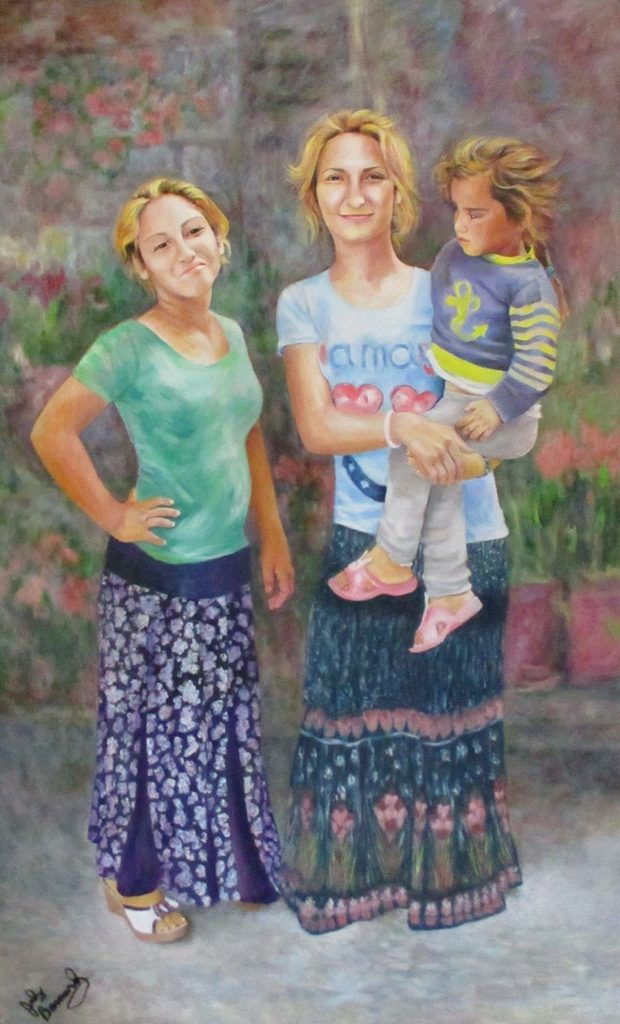Three Roma Girls
48″ x 30″
Oil on canvas
After touring the castle ruins of Dracula,Vlad Tepes in Targoviste Romania we went to lunch. Leaving the restaurant we were accosted by a young Roma girl carrying a child begging money. I knew immediately this girl was Roma/Gypsy. They prefer to be called Roma because the name Gypsy is derogatory. This was my once in a lifetime opportunity to photograph Roma. Her friend or sister noticing she had a likely target joined her. My young guide Marivs was concerned for my safety. I suspect he was aware of their proclivity to pick pockets. I ended up giving the two girls about a $1.25. Roma were documented in Europe from the 1300s. The name Gypsy is a corruption of Egypt. Even in the 1700s linguists had figured out the Roma had come from India by their vocabulary. No one knows for sure just how many Roma there are in the world today. Roma move around changing locations. They refuse to register with the government or send their kids to school. Even after the German Nazis try to eliminate them in World War II it is estimated there maybe 1 million to 1 1/2 million Gypsies in Romania. Roma is short for Romani which has Hindu origin not the country Romania. The book Bury Me Standing by Isabel Fonsaca was recommended to learn more about modern Roma.
Notice these girls do not fit the dark skinned braided hair stereotype of Gypsies. Their skirts are not unusual no beads or bangles. I tried to capture the somewhat arrogant cocky look of the younger shorter girl. I simplified her T-shirt and tried not to put too much emphasis on skirt patterns. Backgrounds are so important I changed it keeping it very loose without detail so it wouldn’t distract from the girls. The goal was to make this a painting not a photograph by changing other small details.
In 2016 the Nelson Atkins Museum of Art featured the exhibition Dutch Painting in the Age of Rembrandt and Vermeer. One featured painting was Winter Scene on a Frozen Canal by Hedrick Avercamp, oil on panel 36.8 x 65.4 cm (14 1/2 x 25 3/4 in). This painting shows two Gypsy women with babies on their backs. One Gypsy mother is reading the Palm of a young single maiden. This painting circa 1634 is the only representation of Roma/Gypsies I have ever seen in the many art museums all over the world. The 3rd Earl of Sussics Thomas Radclyffe in a letter written on his deathbed in 1583 called Robert Dudley the 1st Earl of Leicester a Gypsy. Alison Weir refers to this historical letter in her biography of Elizabeth I. This is definitely used to express disdain of Dudley. There are lots of references to Roma/Gypsies in literature. In the book Dracula 1890 by Brom Stoker the mad pursuit of the vampire Dracula through the mountains of Transylvania, Dracula is aided by his Gypsy minions. In the 1847 Gothic novel Wuthering Heights by Emily Brontë she referrers to Heathcliff four times as a Gypsy. Heathcliff is portrayed as dark complexioned from unknown origins and good with horses. Naturally he is the villain with no redeeming qualities. Jane Austen in her book Emma has Harriet Smith surrounded harassed first by Gypsy children then Gypsy adults. When the authorities search for the Gypsies they have struck camp and disappeared. In most of literature they are portrayed as opportunistic petty thieves. Roma/Gypsies use intimidation rather than violence vanishing before they can be apprehended. The men plied their trade as horse traders, trainers and sometimes horse thieves. The women have traditionally been fortune tellers with crystal balls and palm readers. Besides the name Gypsy or Roma they call themselves Travelers. Roma/Gypsies have updated their scams to fit modern times.
Roma/Gypsies are perceived as thieves. Before going to live in Mexico I was counseled that poor Mexicans are not thieves. If you should be so careless as to leave your garden hose outside unattended you obviously didn’t want it and it was there for the taking. This applies to any unsecured object or unlocked door it was all your fault if things went missing. This trains you to be fanatical about locking car doors and house doors even in secure environments. Roma/Gypsies are so fascinating. Their mysterious culture makes it difficult to limit the story of this painting.





